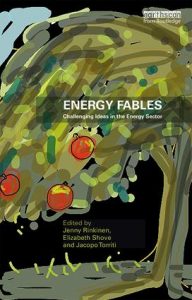Energy Fables: Challenging Ideas in the Energy Sector, edited by Jenny Rinkinen, Elizabeth Shove and Jacopo Torriti (Routledge, 2019) takes a fresh look at key terms and concepts around which energy research and policy are organised.
 Drawing on recent research in energy and transport studies, and combining this with concepts from sociology, economics, social theory and technology studies, the chapters in this collection review and challenge different aspects of received wisdom. Brief but critical introductions to classic notions like those of ‘energy efficiency’, ‘elasticity’, ‘energy services’ and the ‘energy trilemma’, together with discussions and analyses of well-worn phrases about ‘low hanging fruit’ and ‘keeping the lights on’, articulate aspects of the energy debate that are often taken for granted. In re-working these established themes and adding twists to familiar tales, the authors develop a repertoire of new ideas about the fundamentals of energy demand and carbon reduction.
Drawing on recent research in energy and transport studies, and combining this with concepts from sociology, economics, social theory and technology studies, the chapters in this collection review and challenge different aspects of received wisdom. Brief but critical introductions to classic notions like those of ‘energy efficiency’, ‘elasticity’, ‘energy services’ and the ‘energy trilemma’, together with discussions and analyses of well-worn phrases about ‘low hanging fruit’ and ‘keeping the lights on’, articulate aspects of the energy debate that are often taken for granted. In re-working these established themes and adding twists to familiar tales, the authors develop a repertoire of new ideas about the fundamentals of energy demand and carbon reduction.
The book is designed for engineers, economists and policy makers who use and reproduce the ‘fables’ we discuss. Our aim is to prompt readers to pause and think again about the well-worn assumptions on which these positions depend. Buy your copy here.
Many of the fables expand on ideas that are more briefly explained in the DEMAND Dictionary of Phrase and Fable (Seventeenth Edition), available here. Inspired by Aesops’ Fables, and also by Rudyard Kipling’s Just So Stories each chapter features an opening image, sometimes only loosely linked to the topic in question. As well as an introduction and postcript, there are chapters on:
Energy Demand: Jenny Rinkinen and Elizabeth Shove
Some creatures are more insistent than others and quacking ducks can be especially demanding. This chapter explores the social foundations of energy demand.
Energy Services: Janine Morley
Do squirrels distinguish between sources of energy (the nut) and the services that energy makes possible (sustenance)?
Energy Efficiency:Elizabeth Shove
Ostriches are said to put their heads in the sand when faced with danger. Whether ostriches really do this or not, the image of wilfully excluding complicating or extraneous considerations resonates with the main themes of this chapter
Rebound: Greg Marsden
Frogs are good at jumping – but how does one leap affect the next? The concept of rebound relates to the possibility that the benefits of energy-saving actions might be undermined if people use the resources they save in other undesirable directions.
Elasticity: Jacopo Torriti
Spiders make incredibly elastic webs capable of withstanding all sorts of stresses and strains. The concept of price ‘elasticity’ is different. It refers to peoples’ willingness to forego services if prices rise. Activities that have to be done at almost any cost are sticky and inelastic. Others are more flexible. This chapter is about the rigidities and springyness in daily life and how these are organised.
Low Hanging Fruit: Elizabeth Shove and Noel Cass
Low hanging fruit are easy to pick. There is no need to climb the tree, or reach for a ladder. In the energy sector, the phrase ‘first pick the low hanging fruit’ is an instruction to start by harvesting the ‘easy wins’. This chapter discusses the trees and fruits of this metaphorical orchard.
Keeping the Lights on: Gordon Walker
Electric eels have muscle-like cells, called electrocytes. These enable them to deliver electric shocks at any time of the day or night. Electric eels do not light up, but they can produce enough electricity to illuminate up to 20 light bulbs, for an instant.
Promoting Smart Homes: Mike Hazas and Yolande Strengers
A smart robot is an artificial intelligence system that can learn from its environment and build on its capabilities based on that knowledge. Smart robots can collaborate with humans, working along-side them and learning from their behaviour. Some people think smart homes will be able to do the same.
The Energy Trilemma: Jenny Rinkinen and Elizabeth Shove
Like many other animals, real and imagined, giraffes have four legs, not three. The energy trilemma refers to tensions between three poles: energy security, affordability and decarbonisation. Is energy demand a missing dimension?
Flexibility: Jacopo Torriti
Tigers can move at great speed but when stalking their prey, they slink low to the ground. When hunting, they are agile enough to spring into action in an instant and slow enough to wait for the right moment. Are energy consumers similarly flexible?
Non Energy Policy: Sarah Royston and Jan Selby
Chameleons are known for changing colour, and for blending into the background. Many of the policies that matter for energy demand are also well camouflaged. This chapter investigates what are normally hidden forms of policy influence.
